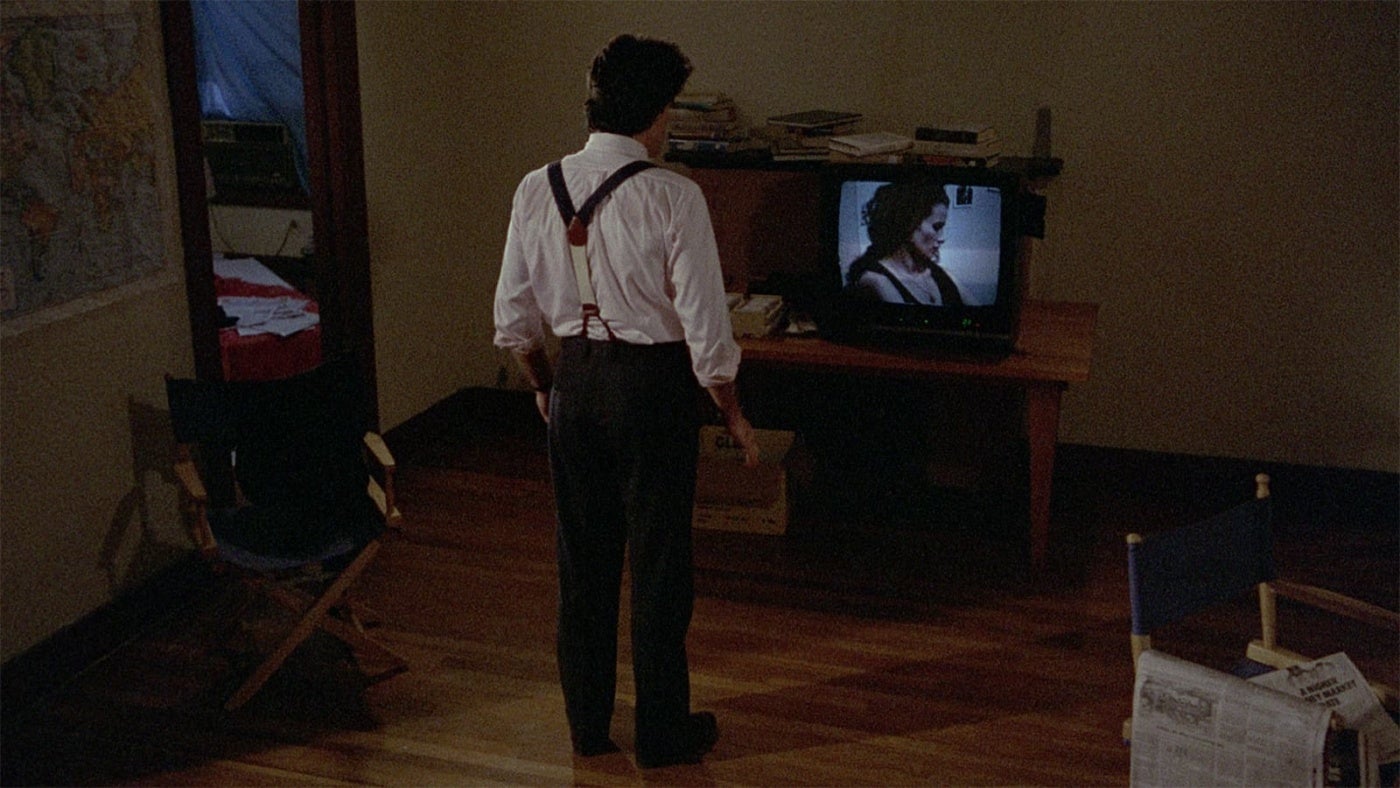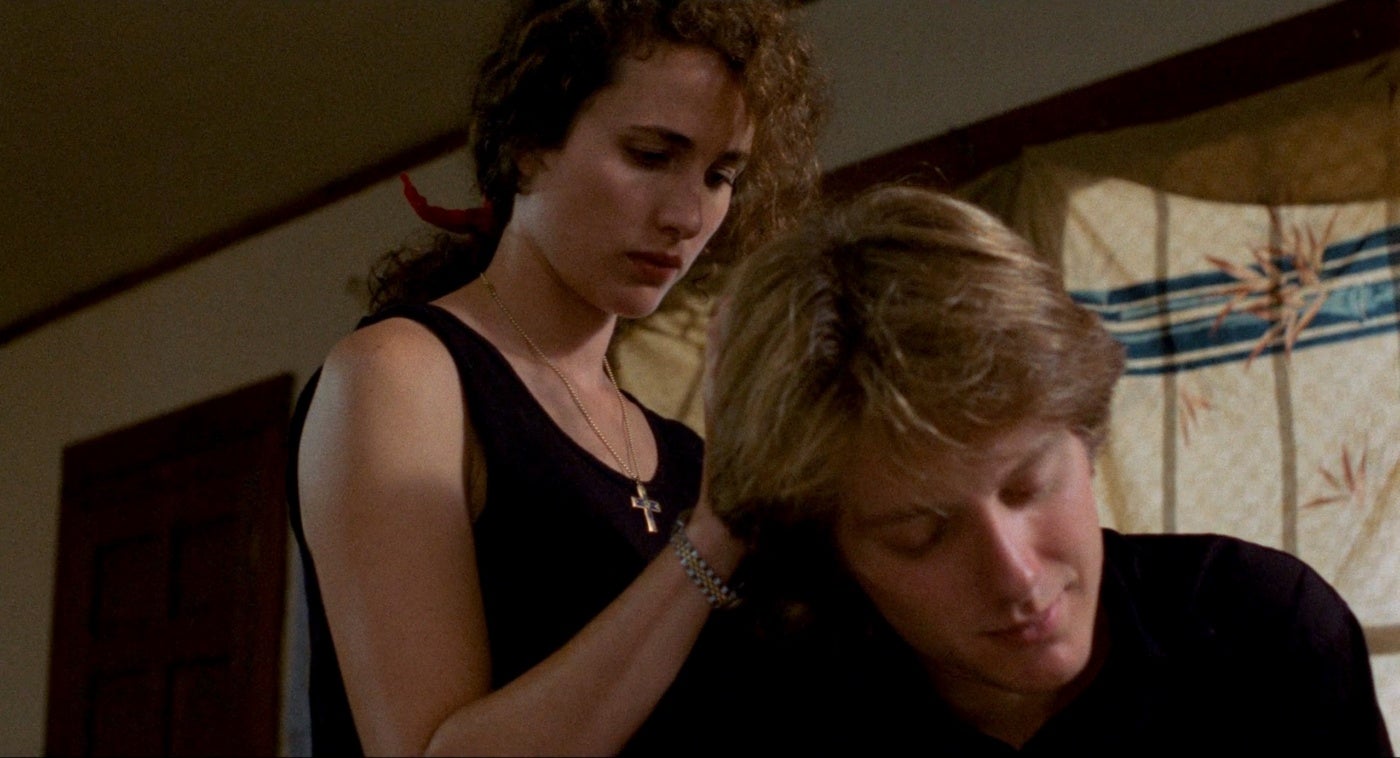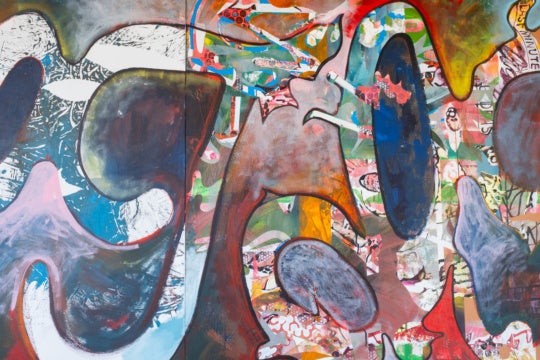It’s summer in Baton Rouge, and everything seems to be sweating : 1989.

Steven Soderbergh’s sex, lies, and videotape (1989) opens with a shot of the road, macadam moving fast under the lens. Graham (James Spader) is about to arrive in Baton Rouge. Meanwhile Ann (Andie MacDowell) speaks to her psychoanalyst about garbage, the state of the world, sex, and how she wishes her husband John (Peter Gallagher) would’ve told her that his old friend from college is coming to stay with them.
Questions Graham asks Ann when he arrives at their home—meeting her for the first time, their shared attraction nearly palpable, upper lips sweating—include: Have you ever been on television? How do you like being married? What about it do you like? At one point in the film, we observe Ann watching Graham sleep. When she leaves the room, he opens his eyes. Graham later tells Ann that he’s impotent, and she says that she believes sex is overrated. Afterwards, she finds videotapes at his place marked with women’s names. He explains that for him, a recovering compulsive liar with a sexual and emotional history that are charged and heavy with mystery, partly because he reveals so little about his past, videotaping women as they talk about their sex lives (“anything, everything…”) is a main form of intimacy. VHS tapes are admittedly more tactile and sensuous than laptops. Fanny Howe describes the transition from analog to digital in The Needle’s Eye (2016): “Black and white films, and for some time, color, were simply a fast-moving series of stills… This is what created the soft filmy look. Now in digital, time is encoded and place is layered.”
It’s summer in New Jersey as I write this essay. On my screen, I click back and forth between sex, lies, and videotape and this document. Soderbergh recently announced he’s writing a sequel to the film, around the same time I started thinking about my time in Louisiana nearly a decade ago, when I moved into a trailer on a lake somewhere between Baton Rouge and Lafayette, Louisiana. We had no mailbox, and the street was unmarked. Upon arriving, I saw an armadillo for the first time. I turned off the car and immediately started sweating. Like Graham, I was simultaneously running toward something and away from something else.
Before moving to Louisiana with F, I was in a relationship with someone who came of age during the sex, lies, and videotape era. He dressed like it was still the early 90s had a huge tower in our apartment which housed a VHS to digital converter, cassette player, record player, every kind of analog or digital recording device. In Louisiana, F and I spent much of our time lounging in bed watching movies, having sex, writing. We lived in relative isolation. I looked at the lake for long stretches. I wondered about my old life and the relationship I ran from. A few months passed and we moved to Baton Rouge where I got a job at a clothing store and worked nights. During the day while F was at work, I’d walk around town and chat with the baristas, go to the movies by myself, wander, drive, sweat.
I remember my time in the South horizontally. Damp, green and creaturely, the landscape housed poisonous snakes, alligators, drowsy giant insects I couldn’t name. The slice of Louisiana I lived in, with its wet verdant planes and slipperiness, reminded me of the pleasure in distraction as I perambulated around the skinny dark green lake behind the trailer. I don’t remember much: haptic and gestural moments, my body leaning into a body of water or the slippery moss under my feet, or unsticking my thighs from hot car seats, films of sweat, touching the anthropomorphic oaks in strange slow motion. Sweat, perpetually on my skin, felt emblematic of some necessary loss, the absurdity of accretion and fierce focus. It was fuzzy, a soft filmy look.
When Graham arrives in Baton Rouge, he becomes the fourth person in an already messy love triangle: Ann’s sister is sleeping with John. She confesses this during her own videotaped interview with Graham. When Ann requests that Graham record her, she eventually turns the camera back on him and begins asking questions. It’s painfully intimate, as though we shouldn’t be there. We view this footage from a different angle, played back to us on tape after John punches Graham, throws him out on the porch, and watches his wife talk about her dissatisfaction. His rage softens into embarrassment, sorrow.

In the second volume of his writings on cinema, Gilles Deleuze wrote, “If we want to grasp an event we must not show it, we must not pass along the event, but plunge into it, go through all the geological layers that are its internal history.” What the film chooses not to reveal visually becomes important. What landscapes are most intimate? Or, perhaps, what does intimacy do to a landscape, how does it charge a place, a view, a horizon? Heraclitus said, “Nature loves to hide.”
In the film, Graham walks over and presses a button on the video camera. A screenful of static falls like a fuzzy curtain. We don’t see the rest, so we lean in. Later, he destroys the videotapes.
It’s a love story.
One day, F told me he had a surprise for me. We drove past verdant fields on traffic-free streets, and I wondered how he knew where he was going. We slowed. In the center of a field was a small split-level house with a movie rental store on the bottom floor. There was a small aquarium with a frog in the corner, which I looked at for a long time. (Learn to read the inner essence of a landscape is one of Werner Herzog’s twenty-four rules for filmmaking and life.) I felt like crying—maybe I did—either because it seemed like the last movie rental place on earth or because I was far from home or felt touched. Tapes are landscapes, soft filmy looks form topographies of intimacy.
It’s a love story.
Even the most climactic moments of Soderbergh’s movie are understated, filled with loud silences, film within the film, softened. Each time I watch sex, lies, and videotape, I can feel the film in my body. It requires leaning in, not knowing. In The Silver Book, a deliberate and sparse poem composed on a typewriter, the poet and visual artist Jen Bervin writes: “write – how you lean in – when you love – write the gentleness there.”
In her book The Skin of the Film (1999), theorist Laura U. Marks writes about embodied perception and spectatorship:
Film is grasped not solely by an intellectual act but by the complex perception of the body as a whole. This view of perception implies an attitude toward the object, in this case a film, not as something that must be analyzed and deciphered in order to deliver forth its meaning, but as something that means in itself.
The environment mirrored my relationship with F—balmy, warm, glossy green and given to overgrowth. Oak trees lined the street, their mossy branches caressing the tops of our heads, feeling human.
Ann touches Graham’s shoulder. He closes his eyes:

I send a message to F, our romance long over, and ask him for photos of our time in Louisiana. He says he hasn’t opened it in a while but, if there are any photos, they’d be in this compressed folder labelled with my first initial: E. Instead of the landscape, I find photos of us, a time capsule zipped in the cloud. I click through the images and zoom in on certain moments behind our bodies: blips of lake water, tangle of chords in his music space, warm and soporific. Much like sex, lies, and videotape, a film which doesn’t reveal much of the Baton Rouge landscape where it was filmed, our bodies are the lens through which I read place.
As far as I know, our lake did not connect to the Mississippi River or any other bodies of water. F reminded me again and again that we were very far south—as though I’d forgotten, as though I needed to be constantly reoriented, situated. And maybe I did.
Sex, lies, and videotape begins by showing the distance between Graham and Ann’s overlapping lives: her voice playing over his drive as he moves unknowingly toward her and the story.
Time passes, things happen.
It ends with their physical bodies overlapping, leaning in—a distance removed, a soft filmy look.
Sex, lies, and videotape (dir. Steven Soderbergh, 1989) won the Palm d’Or at the 1989 Cannes Film Festival. The film is available from the Criterion Collection and at Videodrome in Atlanta.




